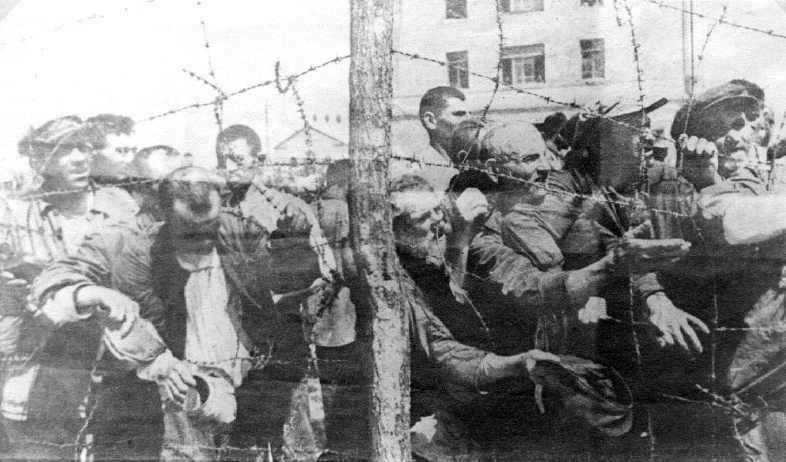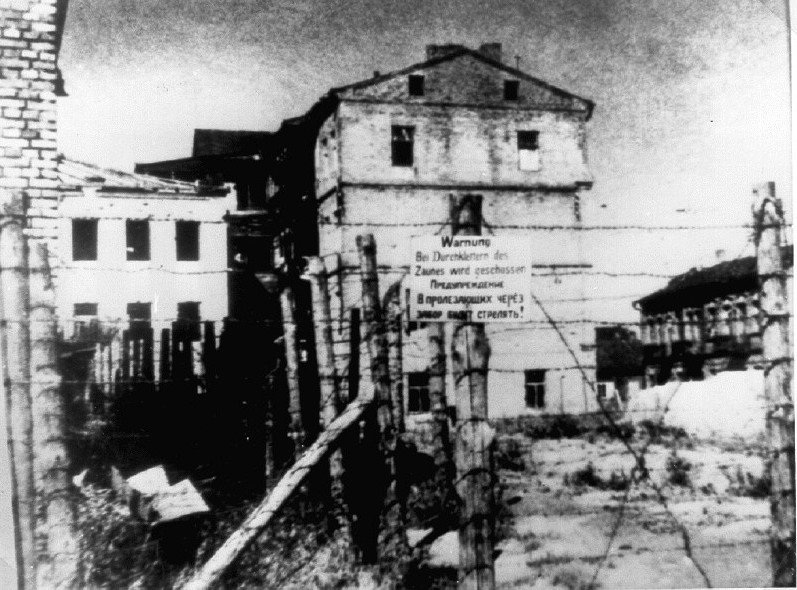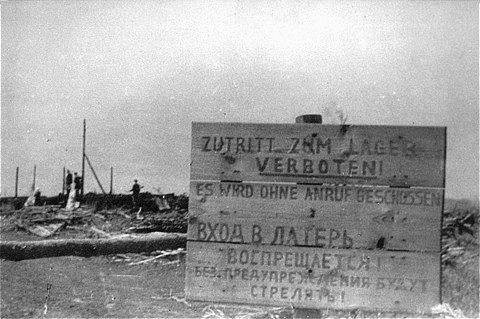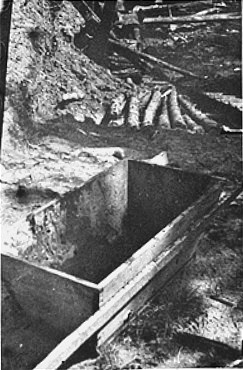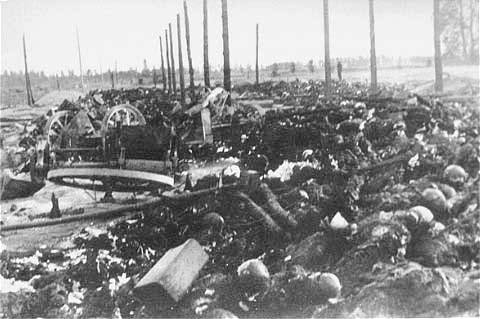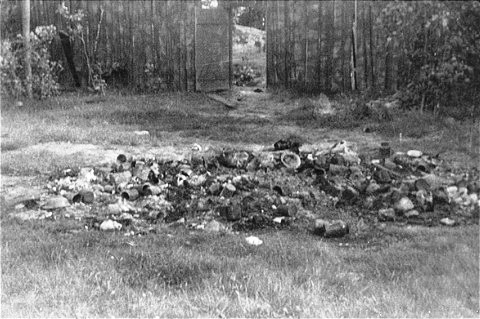Holocaust Education & Archive Research Team |
|
Occupation German Occupation of Europe Timeline
-
[The Occupied Nations]
Poland Austria Belgium Bulgaria Denmark France Germany Greece Hungary Italy Luxembourg The Netherlands Norway Romania Slovakia Soviet Union Sudetenland |
|||
Maly Trostinets The Death Camp near Minsk
Maly Trostinets is a village in Eastern Belorussia some 12 kilometres East of Minsk, where the Nazis established a camp. The site chosen was a former collective farm. Russian prisoners of war and Jews were forced to build the barracks for the six hundred slave labourers and their guards.
The camp initially held Soviet prisoners of war that were captured after the German advance on the Soviet Union, which began on June 22, 1941, known as Operation Barbarossa. But it became a Vernichtungslager, or an extermination camp, on May 10, 1942, when the first transport of Jews arrived there, from Germany, Poland, the Netherlands, Austria, and the Protectorate of Bohemia and Moravia.
However, the primary purpose of the extermination camp was the eradication of the Jewish population of Minsk and the surrounding areas, such as the adjacent village of Bolshoi Trostinets. Jews were killed by means of mobile gas chambers between the 28 July 1942 and 31 July 1942, and subsequently on the 21 October 1943.
However, many were even killed before reaching the camp, as they were brought to the nearby Blagovshchina and Shashkovka Forests, where they were shot in the back of the neck. Most of the victims were lined up in front of large pits and shot. Tractors then flattened the pits out. The prisoners in the camp were forced to sort through the victims’ possessions and maintain the camp.
The killing routine at Maly Trostinets:
Beginning on the 10 May 1942 and continuing every Tuesday and Friday Jews were brought to Minsk from the Protectorate of Bohemia and Moravia, Austria, Germany and driven by truck towards Maly Trostinets. Some of the trucks were gas vans, and after they had been gassed a sonderkommando took them out of the gas vans and threw them into deep pits.
One such transport destined for Maly Trostinets was from Theresienstadt in Bohemia Moravia. On the 4 August 1942 a train with a thousand Jews left the Theresienstadt camp. Six days later it reached Maly Trostinets where it stopped in open country.
Forty “experts” were removed from the train at Minsk. The remaining 960 deportees were ordered out of the train and into vans for the next stage of their journey, and were driven off towards the Blagovschchina forest. The vans were gas vans, once they reached the forest the doors were unlocked and the bodies of the gassed deportees were thrown into open graves.
Of a thousand Jews sent from Theresienstadt to Maly Trostinets in a further deportation on the 25 August 1942 only twenty-two of the younger men were taken to work at an SS farm. The rest entered the gas vans and were murdered.
Of the twenty-two men sent to the SS farm, only two survived the hard labour and brutal treatment of their overseers and escaped in May 1943 to join the partisans. One was killed fighting the Germans and one survived the war, but his name is not known.
On the 23 September 1942 2,004 Jews were deported from Theresienstadt, to Maly Trostinets, there were no survivors. Three days later on the 26 September a further two thousand were deported from Theresienstadt and this was repeated and another two thousand were sent to Maly Trostinets.
Like before there were no survivors and among the dead were Albert Lob from Worms, his wife Katherine and their twenty-four year old son Ernst.
Also killed was Sussel Spatz born in the Austro-Hungarian town of Nowy-Sacz in 1864, whose husband Peter was arrested by the Nazis after the Reichs- Kristallnacht in 1938, incarcerated in Buchenwald then Dachau concentration camps, and who died in 1940 in Dachau.
It was estimated that there were sixty-five thousand bodies buried at Maly Trostinets including those of the Jews killed in the final Action in Minsk. The inmates of the camp were employed in sorting the victim’s possessions or in maintaining the camp, from time to time they were subjected to selections particularly during 1943.
The killing process was conducted as follows: most of the victims were lined up in front of pits, 50 meters long and 3 metres deep and shot to death. After the executions the pits containing the victims were levelled by tractors. The operation was conducted by a unit of thirty to one hundred SS men commanded by an officer named Rider.
In the autumn of 1943 the Germans began to obliterate the traces of the mass murder by cremating the bodies in nearby Blagovshchina forest. There a team of former Red Army soldiers now prisoners-of-war were employed at sifting the ashes in search of gold.
During June 1944 as the Red Army approached, the Germans killed most of the remaining inmates and on the 28 June 1944 the Germans burned the camp to the ground.
That day the camp guards, from Latvia, the Ukraine, Belo-Russia, Hungary and Rumania were replaced by a special SS detachment, all Germans commanded by German SS officers.
This detachment locked all the surviving prisoners, Russian civilians, Jews from the Minsk ghetto and Viennese Jews who had survived in the camp so far, into the barracks and then set fire to them.
All those who were able to flee from the blazing buildings were shot. About twenty former Theresienstadt Jews managed to escape the fire and bullets and to hide in the forest until the arrival of the Red Army forces six days later. As the Soviet army approached in June 1944, the Germans killed most of the remaining prisoners. On June 30 the Germans completely destroyed the camp. When the Soviets arrived on July 3, they found a few Jews who had escaped These Jews were taken to Moscow by their liberators and were incarcerated for two years in a camp in Siberia before being released in 1946.
Sources:
Encyclopedia of the Holocaust State Archives of the Russian Federation The Final Solution by G.Reitlinger published by Sphere Books Ltd 1971. The Warsaw Diary of Adam Czerniakow published by Elephant Paperbacks Chicago 1999. IMT Nuremberg Trial Archives Holocaust Historical Society
Copyright: Chris Webb & Carmelo Liscioto H.E.A.R.T 2008
|
